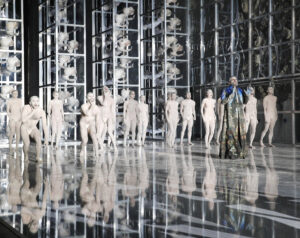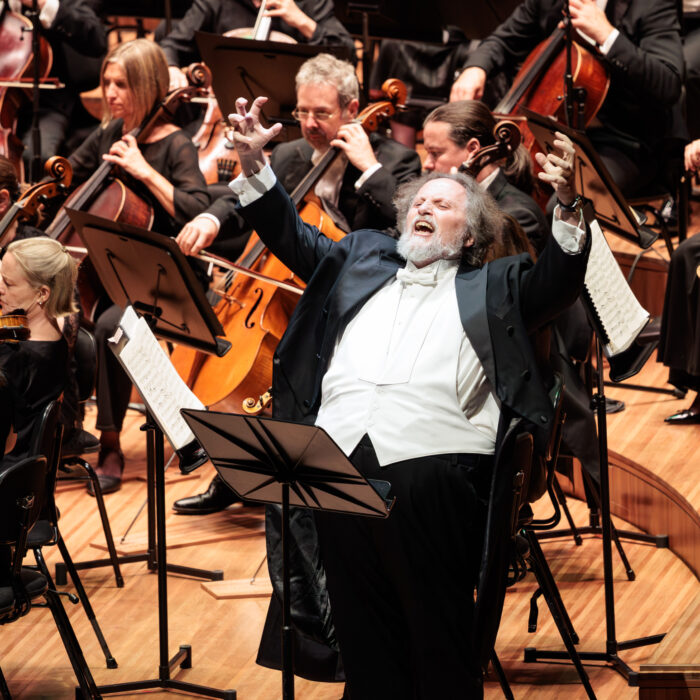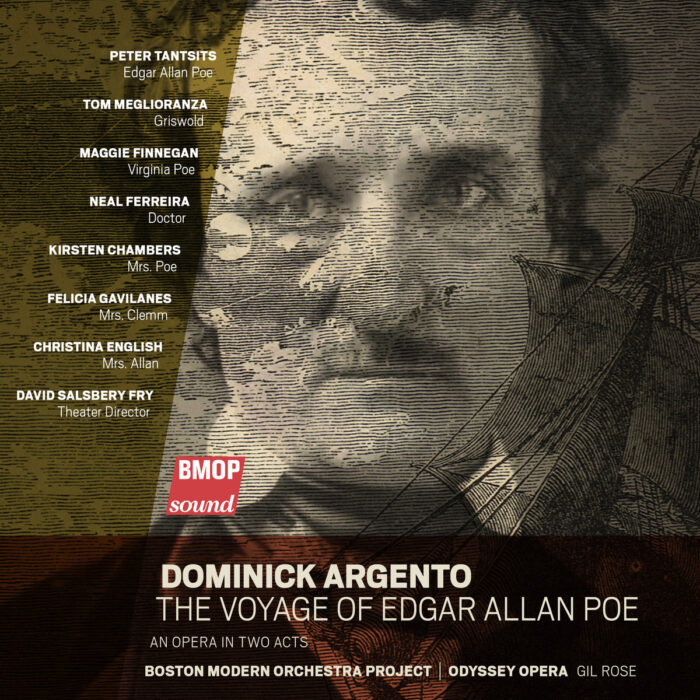
Rossini Opera Festival 2023 Review: Eduardo e Cristina
Stefano Poda’s Unusual Direction Proves Its Worth With A Successful Staging Of A Rossini Rarity
By Alan Neilson(Photo: Amati Bacciardi)
Having just completed his opera “Ermione” for Naples in March 1819, Rossini was under pressure to meet the deadline for a new opera for Venice’s Teatro San Benedetto the following month. He quickly cobbled together numbers from at least four of his past operas: “Adelaide di Bogogna,” “Ricciardo e Zoriaide,” “Mosè in Egitto,” and “Ermione,” along with an aria, “Questa man la toglie a morte” from Stefano Pavesi’s opera of the same name. He also added a sprinkling of new numbers and set them to Giovanni Schmidt’s libretto, revised by Andrea Leone Tottola. The result was the pastiche “Eduardo e Cristina,” and such was its success that it was taken up by Teatro la Fenice the following year. Unfortunately, it has since fared less well, and performances and recordings are few and far between. In fact, this performance is its first at the Rossini Opera Festival, and moreover, it is also the last of Rossini’s operas to receive a premiere there.
Poda’s Poetical Presentation
Reading through the director Stefano Poda’s program notes before the performance was no easy matter, and it was certainly not clear as to what he would be offering the audience for his production of “Eduardo e Cristina.” Some comments were interesting and immediately suggested a foundation upon which he would be basing the production. In his opening paragraph, for example, he talked about Eduardo and Cristina being bound to each other in a way that “one of them cannot exist without the other,” as one finds in works such as “Romeo and Juliet” or “Tristan and Isolde.” However, when he started to expand on this, things became a little more complicated. He wanted to treat the opera “as a work of contemporary art, and transform it into a poem on otherness” and focus on how “opposition and duplicity create a permanent love/death conflict, which is only resolved in the final scene by overcoming the binary vision.”
However, he did offer up one clue as to his staging. “We should not try to make “Eduardo e Cristina” contemporary, but rather universal: not investigate facile messages or inspired interpretations, but rather questions,” and that it would be done by staging the piece as “if it were an exhibition of contemporary art: the background must be a living representation of a world made up of tensions and war, in which opposed and contemporary images alternate.” In the final sentence, he explains, “The happy ending is the recomposition of this polarization, in which the extremes come into contact at the moment when the circle is closed, precisely in the resolution of a binary contraposition.”
His comments appear, at least at first sight, to have little relevance to the actual narrative, which involves intrigue, war, family feuding, and, of course, love. Eduardo is a war hero and secretly married to Cristina, although her father, Carlo, the King of Sweden, is unaware of the fact and wants her to marry Giacomo, a Scottish prince. The couple also have a child and when the king finds out, he flies into a rage and condemns the family to death. During an attack by Russian forces, Eduardo is let out of prison by his supporters and defeats the enemy. He is forgiven by the King, who blesses the union with his daughter.
To be fair to Poda, who also took responsibility for the costumes, lighting, scenography, and choreography, his notes did help clarify the basic ideas behind the staging. The single set appeared to be a mortuary with dead bodies piled up on shelves around the edges of the stage, but it was, in fact, an art gallery, and the bodies were exhibits. The central part of the stage was for the most part left empty, allowing the dancers, who had a pivotal role, to move freely. There were also a couple of glass display cabinets, also used for exhibits, that could be moved easily about the stage.
Illuminating Atmospheres
The costumes for the chorus were basic in design, of no particular period, and colored white or black. The dancers were naked except for loincloths and sprayed in a white clay-type substance. The principal singers wore an array of colorful costumes, which made them stand out from their surroundings. His use of lighting was excellent. Not only did it help in creating different atmospheres on stage, but the way he bathed the stage in a variety of sensitively selected colors was instrumental in generating a pleasing aesthetic.
The presentation rested heavily on the relationship between the dancers, the singers, and the music. While the singers were often fairly static, it was left to the dancers to express and depict the prevailing emotions, forces, tensions, and atmospheres in a physical manner, although not necessarily directly or even in an obvious way, but more often in a poetical manner. The choreography was always inventive and interesting and successfully captured the audience’s attention. Poda also displayed a keen sensitivity to the music in devising the dance sequences. The celebratory march after Eduardo’s initial victory over the Russians was superb. The dancers moved from the left-hand side of the stage to the right, mechanically on all fours, lifting up a leg with the hand, moving it forward, and then flopping onto the ground, rising up and repeating. It was a brilliantly off-centered expression of a march, perfectly in time and in harmony with Rossini’s music.
Against this background, of a “living representation,” of the tensions and forces that drive the narrative, the singers acted out their roles with varying degrees of animation. But, physical contact was often kept to a minimum.
Despite Poda’s highfalutin and opaque program notes that did not fill one with much optimism, his vision came together very effectively and produced an unusual but successful staging that captured a poetic expression of the opera. Although, not one strongly related to the reality as described by the libretto.
Barcellona Leads A Strong Cast
Eduardo was played by mezzo-soprano Daniela Barcellona. She created a convincing portrait of a determined, courageous, loyal, and loving husband and father. She underpinned this with the swagger and confidence of a hero. The role was nicely suited in that it allowed her to show off her impressive ability to adapt her voice to fit her character’s changing moods and circumstances. Her varied palette is capable of beautiful chiaroscuro effects. Her strength in molding the vocal line with detailed inflections, subtle dynamic contrasts, and emotional depth is impressive. Barcellona’s voice is versatile and secure, enabling her to indulge in pleasing embellishments and intricate passages of coloratura.
In the aria “La pietà che in sen serbate,” in which Eduardo implores the heavens to intervene and save the lives of his family, she showed off her sensitivity with a rendition that captured his pain and anguish. Barcellona modulated the vocal coloring and crafted gentle passages of coloratura while coating the line with deep emotion. The detail and delicacy she was able to bring to the piece turned it into one of the evening’s most poignant moments.
Soprano Anastasia Bartoli immediately grabbed the attention of the audience as Cristina when she burst onto the stage with a ringing cry. Her full-bodied voice ripped through the theatre as she moved straight into passages of intricate coloratura. She possesses a formidable instrument that is strong across the range. Her voice takes leaps and runs in stride, attacks phrases with confidence, and allows her emotions full reign. Anastasia Bartoli’s upper register has a real beauty, and when she pushes upwards, her voice opens up wonderfully and without any sense of insecurity. She always appears to be gliding over the line regardless of its complexity.
The role of Cristina allowed her to show off all these features to good effect in what was a very emotional reading. She was in turn loving and gentle, defiant and angry. In the first part of her Act two gran scena, which includes the aria “Ah no, non fu riposo,” surrounded by passages of recitatives, Cristina has awoken from a bad dream. She fears Eduardo and her son have been executed and she wishes for her own death. When Cristina first awakes, her voice is soft and gentle. She sounds somewhat bewildered as she attempts to make sense of what is happening. However, this quickly alters as her anxieties rise to the surface. Bartoli brilliantly captured this moment through her piercing voice, confident leaps, and strong coloratura while holding the line perfectly as her emotions ran wild. In the second part of the gran scena, she realizes her husband and son are safe. She joins Eduardo in a short duet in which her voice takes on a lighter, more joyous tone. Bartoli’s voice rose strongly above the orchestra, chorus, Atlei, Eduardo, and Carlo.
More Stellar Performances…
Tenor Enea Scala’s reading of Carlo, King of Sweden, was that of a complete madman. His movements, facial expressions, and gestures were those of someone completely unhinged and it was brilliantly done. Dressed in a colorful cloak that made him stand out from those around him, he strode around the stage, raging. Yet he was evidently deeply troubled by his inner demons, as made clear by the dancers who crowded in around him or suffered his wrath as he viciously assaulted them. At times, he even appeared paralyzed by fear and on the verge of a breakdown, especially when in the presence of Cristina’s son.
One of the features of Enea Scala’s singing that regularly comes across in his performances is his ability to mold his singing to meet the qualities of the character he is playing, and this was also the case here. Although he possesses a lyrically strong voice with an attractive timbre, he is able to imbue it with the necessary emotions to convince in his role. It was possible to hear his anxiety, aggression, fear, and hope as he colored and inflected his voice. His wonderful aria “D’esempio alle alme infide,” in which he rages at Cristina before embracing her and her son in a show of tenderness, which he then rejects as a weakness, displayed his ability to convincingly portray a range of emotions. It also allowed him to show off the beautiful lyricism of his voice, his intelligent phrasing, impressive vocal versatility, pleasing coloratura, and the ease with which he is able to caress the melody.
Bass Grigory Shkarupa’s portrait of Giacomo as a decent and straight-laced, although somewhat passionless, man made it understandable why Cristina was not keen on the prospect of marrying him. He cut a lame figure next to the swashbuckling hero, Eduardo. Shkarupa possesses a distinctive and resonant voice with a pleasing weight, which he successfully used to reinforce this impression. His recitatives were expertly forged and underpinned by the sincerity he was able to bring in their delivery.
Tenor Matteo Roma as Atlei, the captain of the guard and trusted friend of Eduardo, produced a solid performance. His recitatives were carefully crafted to bring out his character. They possessed the necessary energy and verve to maintain the forward momentum of the drama, and his singing fitted neatly with the numerous ensembles.
Magic on Stage and in the Pit
The conductor, Jader Bignamini, elicited a lively and dramatically taut reading from the Orchestra Sinfonica Nazionale della RAI. He ensured the orchestra maintained a strong momentum with a pleasing balance. His judgment of when to assert the orchestra or to subsume it within the wider musical and dramatic fabric was excellent. His musical textures were carefully managed. This was a particularly clear sound. Melodies were superbly crafted and the attention he gave to both the singers and dancers ensured a strong sense of unity between the stage and the pit.
The Coro del Teatro Ventidio Basso, under the direction of Giovanni Farina, made a strong contribution. They performed with plenty of energy and sensitivity.
Overall, this was an excellent production. The staging, although very unusual in its conception, worked splendidly. It was imaginative, inventive, and, at times, aesthetically stunning. If it did not exactly represent the drama in a realistic sense, it nevertheless certainly managed the narrative to create a piece of thought-provoking and pleasing theatre. However, I am not sure what audience members who had not read Stefano Poda’s program notes thought about it. To say the least, it must have been a little baffling. However, whether or not one was able to make sense of the onstage action, musically, it was a first-rate production.



